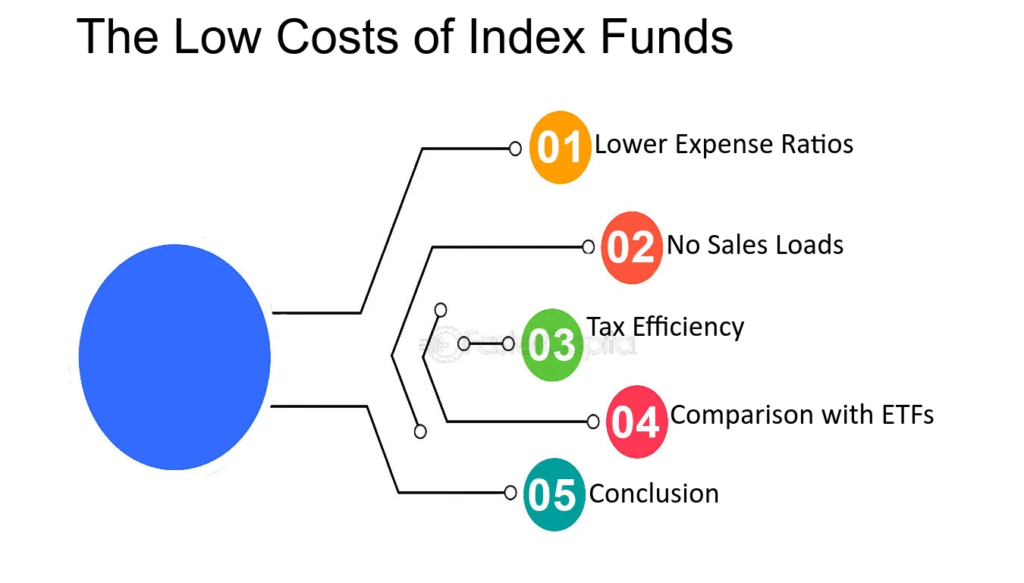low-cost index funds returns
Low cost index funds are investment funds that seek to replicate the performance of specific market index, such as the S&P 500 or a bond index, while keeping fees and expenses low. These funds aim to match the returns of their respective indexes as closely as possible, rather than attempting to outperform them.

The returns of low cost index funds are primarily determined by the performance of the index they track. When the market or index performs well, the fund’s returns tend to increase correspondingly. Conversely, if the index underperforms or experiences losses, the fund’s returns will be negatively affected.
Low-cost index funds for beginners(low-cost index funds returns)
- Diversification: By investing in a fund that tacks an index, you get exposure to many different stocks or securities in one investment. This helps spread out your risk.
- Ease of Use: Index funds follow a market index, so you don’t have to worry about picking individual stocks or making investment decisions.
- Steady Growth: Over time, index funds often provide steady growth that can help your investments increase in value.

- How to start:
- Determine Your Goals: Think about what you want to achieve with your investment, such as saving for retirement.
- Choose an index: Decide which market index you want to track, like the S&P 500 or total stock market.
- Find a Fund: Look for an index fund with a low expense ratio that tracks your chosen index
- Open an Account: Select a brokerage firm where you can buy the index fund. Look for one with low fees and an easy to use platform.
- Start Investing: Invest a lump sum or use dollar cost averaging to build your portfolio over time.
Example of Low cost Index funds
- Fidelity Zero: Total Market Index Fund: This fund offers exposure to the U.S. stocks market with no expense ratio.
- Ishares Core S&P 500 ETF: This ETF tracks the S&P 500 index and has a low expense ratio.
- Monitoring Your Investment: Check regularly your investment occasionally to ensure it’s performing as expected.
- Stay Informed: Keep up with market news and trends to understand how your investment might be affected.
- Low cost index funds are an excellent choice for beginners because they offer simple affordable way to invest in the stock market.
Here are some Top low cost index funds in India

- SBI Nifty 50 Index Fund: This fund tracks the Nifty 50 index, offering exposure to the top 50 companies listed on the National Stock Exchange (NSE). It is known for its low expenses ratio.
- UTI Nifty Index Fund: This fund follows the Nifty 50 index and is known for its competitive expense ratio. It provides broad market exposure to the largest companies on the NSE.
- ICICI Prudential Nifty Index Fund: This fund also tracks the Nifty 50 index and offers a low cost option for investors. It is a reliable choice for diversified exposure to the Indian market.
- HDFC Index Fund: This fund tracks the BSE sensex index, giving investors exposure to the top 30 companies listed on the Bombay Stock Exchange (BSE). It offers a low expense.
- Aditya Birla Sun Life Nifty 50 Index Fund: This fund mirrors the Nifty 50 index and is known for its low fees and consistent performance.
- These Index funds offer investors exposure to major Indian stock market indices like the Nifty 50 and the sensex while keeping costs low through minimal management fees.
Low cost index fund calculator
A low cost index fund calculator helps you estimate how much your investment in an index fund can grow over time. The calculator uses a few key inputs to give you an idea of your potential future returns.
The calculator needs your initial investment amount, which is how much you start with. It also needs your monthly contributions, which is the amount you plan to invest each month .You’ll also need to enter the expected annual return, which is the amount you plan to invest each month. You’ll also need to enter the expected annual return, which is the average annual return you expect from the index fund, often based on historical performance.
Another important input is the investment period, which is the number of years you plan to invest. Finally, You’ll need to include the expense ratio, which is the annual cost of managing the fund, usually expressed as a small percentage of your investment.
Once you input this information, the calculator will estimate how much your investment could grow over time. You’ll see how much you investment could be worth at the end of your chosen investment period.
Using a low cost index fund calculator can help you plan your investments and see how different amounts and time periods can affect your potential investment. You can find these calculators on many financial websites and investment platforms.
low-cost index funds returns
Look out our most viewed articles Investment Strategies for innovative people





